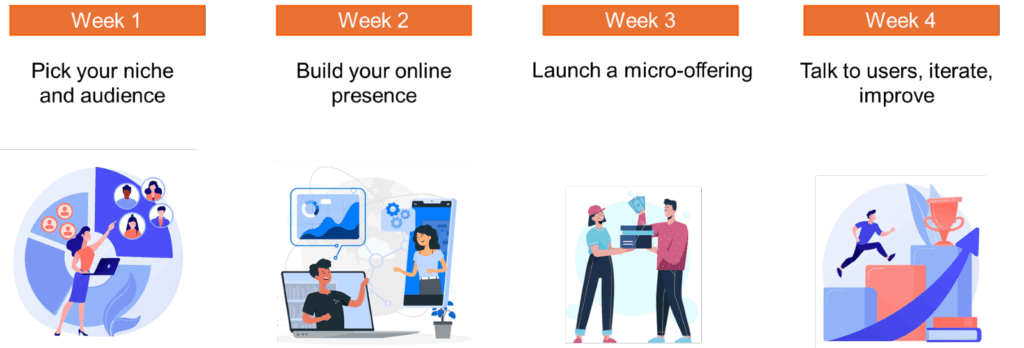Recent times have seen a surge in the youth embracing gig economy and freelancing opportunities. At Schbang, a digital marketing agency I co-founded,1200 employees worked, and we had a large pool of young minds. Whenever someone quit, I would pose them a question, “What are your future plans?”. To my surprise, 80% of them confidently declared, “I plan to do something on my own; I plan to freelance” or “I plan to move to Bali or Goa and figure things out from there”. Without a job in hand, their optimism to venture on their own was commendable. Many of my colleagues and employees even balanced gig work on the side as full-time employees – a testament to how democratized the entire solopreneur ecosystem has become, allowing people to work at a time and place of their choice.
Why is Gig and Freelance Economy Growing?
India’s gig economy model has experienced a phenomenal growth – 17% CAGR which was expected to reach a gross of $455 billion by the end of 2024 and the freelance workforce is projected to reach 23.5 million by 2029-30, an exponential increase from 7.7 million seen in 2021. So why is it growing so rapidly in the recent years? The pandemic has accelerated this trend. Majority of the population, especially youth, learned that physical presence is no barrier to deliver results which encouraged this shift into gig economy.
Several key factors attribute to this rapid development:
- Digital transformation: where tech platforms eased remote, project-based work.
- Flexibility: Flexible work culture attracts the youth and skilled professionals.
- Government support: Policies like e-Shram improves social security among the freelance community.
You may be interested to read: Key Tips to Build Your Career Path and Achieve Success
Solopreneur vs Entrepreneur
Solopreneur is an individual who runs an entire business on their own devoid of partners or employees from strategy and content to execution and finance management unlike entrepreneurs who build teams to manage a company. We can find various kinds of solopreneurs today:
- Creators: They are individuals who create content and monetize their time and expertise through their online presence in social media platforms like LinkedIn and Instagram.
- Freelancers: These are professionals who work project-basis. They take up short-term projects and offer their skillsets to achieve a specific outcome. The projects could be as simple as designing 10 Instagram posts or UI/UX of a website and submitting it to the client.
Further reading: How to become a UI/UX designer – Online Manipal
- Consultants: Unlike freelancers, consultants like me, undertake long-term projects with companies and provide domain expertise to help them transform their brands. These are strictly knowledge-based projects and the fact that it is long-term, provides peace of mind regarding recurring revenue every month.
- Niche product builders: They also take up short-term projects with a focused agenda but instead of projects, they build tech enabled or content-driven products.
Real Life Examples of Solopreneurs
- Raj Shamani: Raj, a friend of mine, started off his journey by just making content on Instagram. Today, he has progressed to become one of the top podcasters in the country monetizing via LinkedIn and even YouTube and has a big team helping him through his journey.
- Ankur Warikoo: Ankur also started off solo, building educational content, now he sells courses around entrepreneurship and personal branding.
- Nuseir Yassin: Yassin, popularly known as Nas Daily, started off as a Solopreneur travelling to different parts of the world making 1 minute content. Now, he runs a creator conference Nas Summit globally for creators across the world.
The Maker Mindshift
It’s important to understand that there needs to be a mindset shift when you’re moving from a career as an employee in a company to becoming a solopreneur. It’s essential to introspect and understand the following:
- From job seeker to value creator: Where you can add value and what skillset to monetize.
- From waiting for opportunity to designing your own opportunity because as a solopreneur, you’re always looking for newer ways and fashions in which you can add more value, drive more business, and make more money.
- From thinking about resources to thinking about resourcefulness: Instead of thinking about finding resources and building a team, think about collaborating with other solopreneurs who possess complimentary skills and provide a combined service instead of hiring.
The Six Pillars
Solopreneurship is built on six pillars. Let’s try to decode these pillars:
Pillar 1: Problem Picking
For anyone venturing into the gig or freelancing space, finding your niche and being known for it is paramount. This involves the Passion, Proficiency, and Market framework. Find your passion, know what you are proficient in (knowing your niche), and finally, find a market to monetize your niche and be known for it. For example, I am trying to create content. More specifically, I am making content around ‘agency life’ which is my niche. So, when someone thinks of ‘agency life’, I want to be known as an expert in that industry.
Pillar 2 – Personal Branding
One of the most important aspects around building yourself as a solopreneur is, personal branding around your niche. The barrier to entry for content creation today is absolutely zero. With just a smartphone, you can create content and reach your audience.
You may wish to explore: Building personal brands in a digital world – Online Manipal
Pillar 3 – Distribution is King
Your distribution channel is equally important as compared to content creating. Be in touch with people who might be interested in your niche and services you have to offer. You can achieve this via channels like emails, WhatsApp, and collaborations.
You can use tools to build database and reach people interested in your niche. Platforms like Gumroad and Fiverr allow you to meet people and take up gigs. Notion is a platform primarily used from the perspective of keeping in touch with team members These could be collaborators across the world but working together on projects through notion.
Pillar 4 – Monetization Models
In the freelance ecosystem, monetization for the work is something that needs to be cracked only by the solopreneur. Typically, basis the time and efforts put in for a short-term project, the solopreneur needs to decide the pricing appropriate for the outcome.
The barrier for entry into freelancing is absolutely nothing. Some ideas for monetization include creating short e-books related to templates and courses on LinkedIn and selling them for a mere amount. Another unique model used by many creators today is the ‘affiliate model’ or ‘performance-based model’ where the solopreneur creates content that reaches their audience and provides a promo-code to purchase the item being sold thus earning an additional amount of money.
You may also be interested in: How to become a Content Writer in India – Online Manipal
Pillar 5 – Systems & Tools stack
To deliver exceptional results, sticking to schedules is a necessity for solopreneurs. Hence, many creators use tools to keep them on track:
- For task management: Notion, Trello, and Google Calendar
- For communication and collaboration: Calendly, TopMate
- For payments: Razorpay, Stripe
- For Automation: Zapier, Canva, ChatGPT
In today’s AI-driven world, it’s essential for us to learn how to use it. As I always say,
AI will not take away jobs but people who do not learn to use AI, will definitely be replaced.
You may wish to explore: Debunking misconceptions about artificial intelligence and employment – Online Manipal
Pillar 6 – Mental health & Consistency
- Avoid Burnout
There are many mental health issues that comes with working alone. Solopreneurs often lose motivation and get burnt out quickly because there is no one to talk to. So, while you are being a solopreneur in a particular niche, it’s very important to find a mentor who can be your guide and advisor on this journey.
- Build a tribe, set rituals
Contact and collaborate with people who are faring well in the industry. Meet for a cup of coffee, catch a breakfast together, converse, and seek help in order to stay relevant.
It is okay to say no – when you do not have the bandwidth to take up a certain project. It’s better to deny than to take it up and not deliver your best.
- Design your ideal week
It is necessary to design your week apart from the work you do. Make time for your hobbies and physical health. This will help provide much more clarity and refreshment for you to ace your next day!
Mistakes to Avoid
- Waiting for the perfect plan
- Doing too many things
- Under-pricing your work
- Not building in public
- Building short-term only
Solopreneur Sprint Plan

Final Thoughts
Today there is a market for solopreneurs, for freelancers, and for gig workers which is completely untapped. It’s just about introspecting, finding what a passion is and just taking it live honestly. Do not hesitate to challenge yourself, stay inspired, and stay motivated!
Prepare for your next career milestone with us












